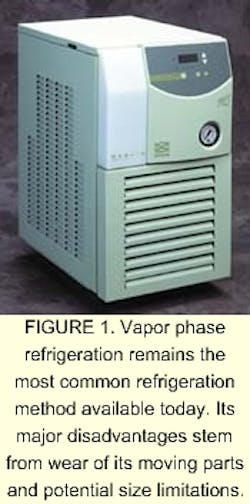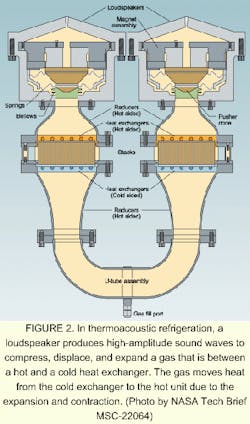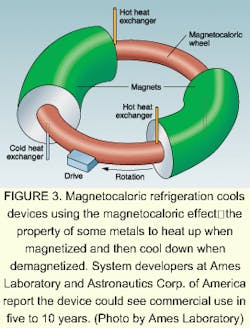Smaller lasers demand new approaches to chiller design
Stu Krupnick
Vapor-phase refrigeration may still be the most common chiller type, but other options, from thermoelectric or Peltier cooling to magnetic refrigeration, are being evaluated.A chiller is basically a temperature-controlled liquid recirculator that removes heat from an instrument using a fluid as the heat transfer medium. In many cases, the instrument must be kept at a constant temperature as well. This requirement is typical for laser cooling. There are many types of liquid cooling methods, but the vast majority of chillers utilize vapor-phase refrigeration (VPR). It is one of the oldest means of mechanical refrigeration and is used extensively in home refrigerators and automobiles. Few other refrigeration technologies have proven to be more efficient and as cost-effective, but some promising new methods may be commercially available within the next decade.
The current direction in chiller technology, dictated mostly by the laser and semiconductor industries, has been to supply a reliable chiller with a high amount of heat removal in a very small package using a relatively low amount of electricity. Many companies have been able to offer VPR systems that meet most of these requirements with a combination of plate-style evaporators, new refrigerants, and condensers with improved heat-transfer materials. Still, many laser users are asking for yet smaller and more efficient chillers, and VPR chillers soon may reach their size limit.
Chiller basics
A VPR system consists of a compressor, condenser, and evaporator. A chemical (refrigerant) with a very low boiling point is used to remove heat from the liquid to be recirculated for cooling (process fluid). Two common refrigerants, R22 and R134a, are in a gaseous state at room temperature and atmospheric pressure. Basically, during operation the refrigerant is recirculated internally and used to absorb heat from one location (process fluid), which is then moved to another area (rejection to the air or another source of water). The refrigerant enters the compressor as a hot gas and is compressed. After that, it is routed to the condenser where it condenses into a cold liquid. The cold liquid then enters the evaporator where the process fluid is cooled to the user-defined temperature set point. As the refrigerant removes heat from the process fluid, it changes state back to a hot gas. This hot gas returns to the compressor, and the process is repeated. In a laser chiller, a temperature controller on the chiller monitors the process fluid temperature and adjusts the refrigeration system to maintain this set point.
Vapor-phase refrigeration is still the most efficient, commercially accessible refrigeration method available today. It is also the most powerful. No other type of system can provide the level of heat removal over a wider temperature range. The major disadvantage of VPR is that it is a mechanical method. In other words, there are many moving parts. Some of them include the compressor, fan, fan motor, and refrigerant metering valves. Moving parts, unfortunately, wear out over time. A more ideal refrigeration method would be a powerful, energy-efficient cooling system with no or minimal moving parts.
One of the more simple cooling devices that is well suited to small laser cooling is an air-to-water heat exchanger. It consists of a condenser similar to a car radiator, a fan, and a pump. For small heat removal applications, such as cooling a laser diode, an air-to-water chiller can meet the small size and low electricity requirements. However, since air-to-water exchangers are relatively inefficient, a heat removal requirement greater than 1 kW will result in a rather large-sized unit due to the amount of surface area required for the condenser. Additionally, an air-to-water heat exchanger cannot cool the process fluid below the ambient temperature. For these reasons, air-to-water exchangers can only meet a narrow range of cooling requirements.
Thermoelectric or Peltier cooling is a commercially available refrigeration method that can cool air or fluid below ambient temperature without the use of moving parts. The method uses p- and n-type semiconductors sandwiched between two ceramic plates. If a positive dc voltage is applied to the n-type semiconductor, electrons will move to the p-type semiconductor, creating a hot side and a cold side. The system will cool process fluid by circulating it through a heat exchanger in contact with the p-type side.
The thermoelectric cooling system can be an excellent method of removing heat from small heat loads. Virtually no moving parts are used, and the system is very quiet. It also can be quite small physically. There are disadvantages, though. The electricity requirements of a thermoelectric chiller can be two to three times higher than with a VPR system, and the power supply required is quite complex. Additionally, the efficiency of a thermoelectric chiller is much lower than for a VPR system, making thermoelectric cooling impractical for large heat removal applications such as carbon dioxide, Nd:YAG, or argon-ion lasers.
Future technology
There are a few experimental refrigeration methods that may prove to be practical for cooling small lasers within the next five to 10 years. Thermoacoustic refrigeration, for example, was developed by the aerospace industry as a method that would work in any orientation and at zero gravity (see Fig. 2). A loudspeaker produces high-amplitude sound waves to compress, displace, and expand a gas that is between two heat exchangers. One heat exchanger is hot, and the other is cold. The gas moves heat from the cold exchanger to the hot unit due to the expansion and contraction. The advantages are no moving parts and no use of potentially ozone-depleting gases.1
Another refrigeration technique still in development is magneto caloric refrigeration, which uses a wheel embedded with segments of magnetic material spinning around a strong magnet (see Fig. 3). As the magnetic material passes through the magnetic field, it heats up. The material cools as it moves out of the magnetic field. If the wheel is in contact with a heat exchanger, the process fluid can be cooled. This technology is still in its infancy, but the potential for magneto caloric refrigeration to remove large amounts of heat is excellent.2
Overall, the laser industry's requirement for smaller and more efficient chillers is being driven by the growing popularity of low-heat-load laser diodes. While vapor phase refrigeration is by far the best, most economical, and efficient refrigeration method, other technologies are also suitable for removing small amounts of heat. Whether lasers will be cooled with magnets or loudspeakers in the future remains to be seen, but it is safe to say the chiller industry is constantly striving to produce smaller, more powerful, and more efficient chillers to meet the needs of the laser market.
REFERENCES
- S. L. Garrett et al., J. Therm. and Heat Tran. 7, 595, AIAA (1999).
- G. Schneidner Jr., Magnetic Refrigeration, Ames Laboratory, Ames, IA (1999).
STU KRUPNICK is a marketing manager with Thermo Neslab, POB 1178, Portsmouth, NH 03802; e-mail: [email protected].



